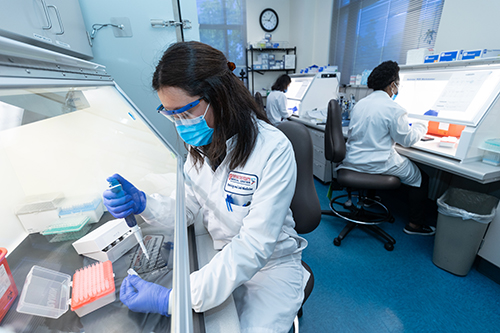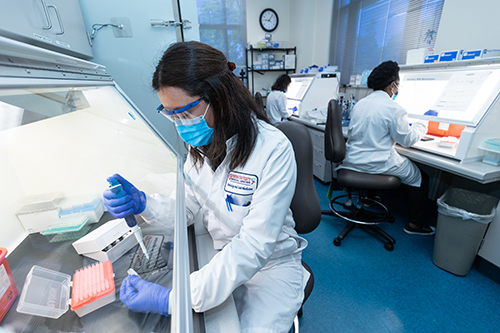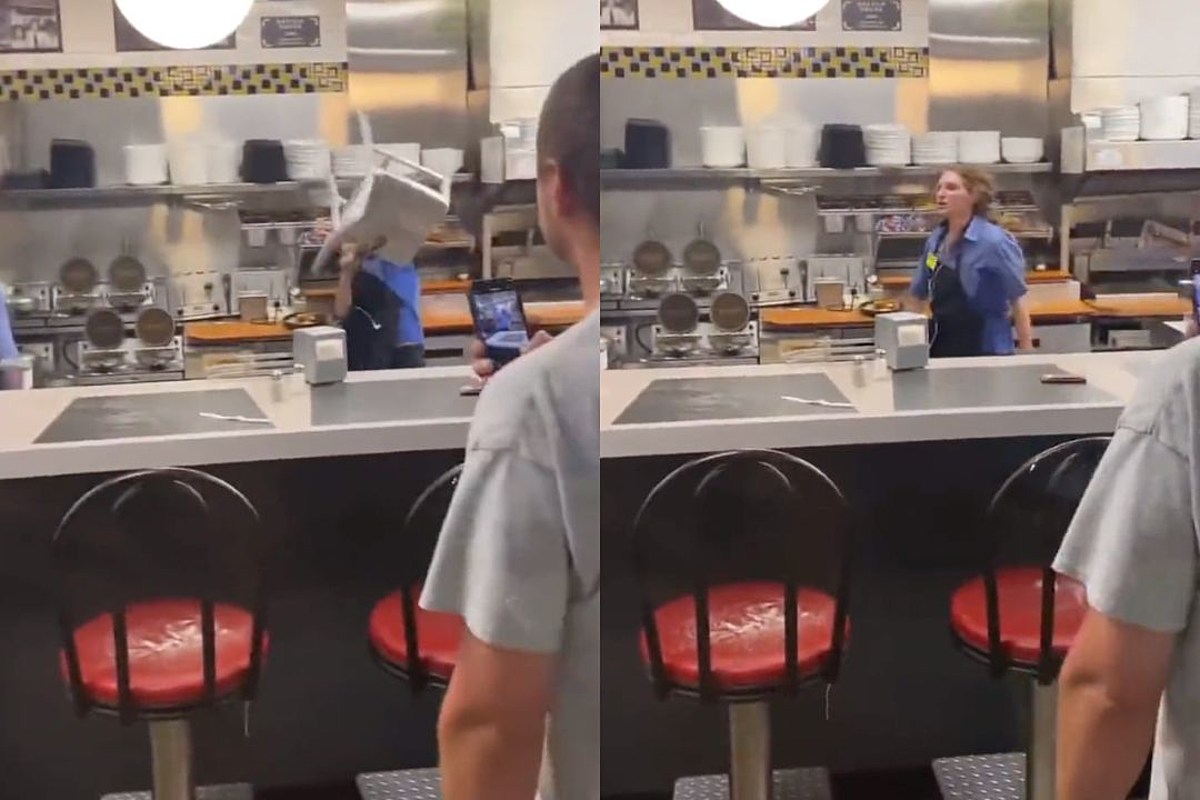
As things seemed to be calming down following the peak of the COVID-19 outbreak, clinical laboratories should have gotten a bit of a reprieve. Instead, they found themselves facing a new challenge this year: monkeypox. The current outbreak of monkeypox, declared a public health emergency in August by the U.S. Department of Health and Human Services (HHS), caused an initial scramble for laboratory directors and personnel, most of whom never expected to be responding to another emerging viral disease so soon.
After a few hiccups early on, there now appears to be plenty of capacity for testing, approved laboratory procedures for working with specimens, and even an emergency use authorization (EUA) in place from the Food and Drug Administration (FDA) to allow for quick approval of additional laboratory testing options. Still, some lingering issues remain regarding sample collection quality, as well as questions about who will cover the cost of tests, if testing can expand beyond lesion material, and how the virus may evolve over time.
Learning from the COVID-19 pandemic, government agencies worked quickly to expand testing capabilities from public health laboratories to additional commercial labs, and they allowed the use of additional platforms and equipment to move things along. The expansion was three to four times what was seen during COVID-19, said Demetre Daskalakis, MD, MPH, deputy coordinator for the White House National Monkeypox Response. It has helped that the demand for testing hasn’t approached that of COVID-19, either.
Like COVID-19, it’s unlikely monkeypox will be eradicated, said Matthew Binnicker, PhD, director of clinical virology at Mayo Clinic in Rochester, Minnesota, and vice chair of practice in the Department of Laboratory Medicine and Pathology. “Labs likely will be testing for monkeypox in the future, and it may be something that we test for alongside other causes of dermal and genital diseases like herpes or syphilis,” he said.
Laboratory Response Network Springs to Action
Public health laboratories found themselves on the frontlines of the monkeypox response. Soon after the first case was reported in Boston in May, the Centers for Disease Control and Prevention (CDC) began weekly communication with its Laboratory Response Network (LRN), a collection of some 120 sites (mostly state and local public health laboratories) called on to respond to public health emergencies, said Christina Hutson, PhD, branch chief of the Poxvirus and Rabies Branch at CDC and lead of the CDC Monkeypox Laboratory and Testing Task Force. About 73 of these labs use a FDA-approved assay designed by CDC to test for non-variola orthopoxviruses.
Prior to the outbreak, Hutson said, state epidemiologists would counsel clinicians to determine if pox testing was warranted, and they requested that LRN laboratories send samples to CDC for additional molecular testing and potential sequencing to characterize the monkeypox clade and lineages circulating. As cases increased, the process quickly evolved so that anyone presenting with lesions was encouraged for testing, and labs were given the option to send just 10% of their samples for further evaluation, she said.
“We were in a very different place from COVID-19, because this is a virus we’ve studied for many years, although this outbreak had differences, so we are still learning,” Hutson said. “We already had some tools available, including an FDA-cleared test, ready to go. What we saw, though, was although testing capacity was sufficient, it was testing access that needed improvement.” This challenge was exacerbated by people unfamilair with the process of going to a public health laboratory or feeling like that was inconvenient or too cumbersome.
Pivot to Expanding Access to Testing
CDC and other agencies took steps to help increase testing capacity. In June, CDC received approval from FDA to expand their test from only manual extraction, to add an automated extraction platform and another PCR platform to increase laboratory capacity and flexibility in what equipment could be used, Hutson said. CDC, FDA, and the HHS also expanded monkeypox testing to five commercial laboratories including Aegis Science, Labcorp, Mayo Clinic Laboratories, Quest Diagnostics, and Sonic Healthcare. They also supported non-LRN labs in developing their own tests by publishing primers and probes for CDC PCR tests.
“What we are seeing is a lot of academic medical centers come online with their own laboratory-developed testing,” said Jennifer Mahn, MPA, director of clinical and sexual health for the National Coalition of STD Directors. “If they’re CLIA certified or under an IRB for research, they can do [monkeypox] testing with probes or primers available from some of the firms, and control reagents or state lab positives if the public health lab is willing to give those.”
CDC has a website dedicated to laboratory testing data for monkeypox, and data indicates that testing capacity for now far exceeds testing demand. As of September 28, 110,920 specimens have been tested, with 28.2% cumulative positivity rate. The available capacity is 93.8%.
“Initial concerns about the availability of laboratory tests were very much colored by the concerns that arose at the beginning of COVID-19,” said Ewa King, PhD, chief program officer at the Association of Public Health Laboratories. “We see that it was somewhat unjustified because the capacity is plentiful.” The PCR test started as a manual extraction, but very quickly the CDC got FDA approval to amend the 510(k) for the CDC PCR test to add one automated extraction platform as well as additional enforcement discretions to allow the use of other automated extraction platforms to push this into more of a high-throughput test category, she said.
There still have been a few issues laboratories are facing, said Binnicker, whose lab has been testing about 100 monkeypox samples a day since July. While large commercial labs have partnered with CDC and HHS to expand testing, “most hospital and small clinical labs don’t have access to monkeypox tests. So that’s causing a delay in the turnaround time for results for some patients if samples have to be sent to one of the [commercial or LRN] labs.”
That could change in the foreseeable future, as FDA in September released guidance for EUA requests for additional monkeypox diagnostic tests. The agency also provided voluntary templates that test developers can use when validating a test or submitting EUA requests. There also may be more options for rapid tests over the next 12 months, Binnicker said.
“We generally see this as a good development to have some process for registration and FDA review, when appropriate, of newly produced or modified tests,” King said. “This can make tests available in locations where they have not been available yet, and at the same time, make sure that these tests perform well … and assure that laboratory-developed tests are of sufficient quality to be really helpful in the response.”
Education and Safety for Lab Personnel
Education and safety for lab personnel working with samples also quickly evolved with the outbreak. For labs performing viral culture, monkeypox presents a safety risk to laboratory staff, Binnicker said: “We’ve actually had to discontinue viral culture of dermal and genital samples, because we don’t want to inadvertently grow monkeypox and expose our staff.”
Binnicker said that prior to 2022 he was familiar with monkeypox, but had not seen a case of the viral infection. “I don’t think there is a strong understanding of monkeypox by most laboratory professionals or general physicians. This is something that we have not tested for or had to deal with prior to July of this year.” Binnicker soon found himself giving presentations about the basics of monkeypox to his department and keeping them updated on testing protocols, including how to keep lab staff safe.
At Mayo Clinic, it’s standard for staff to work with samples inside a biosafety cabinet, Binnicker said. Working inside of a laminar flow hood keeps the airflow in a certain direction and minimizes the chance of exposure. Laboratory personnel also wear a gown, gloves, and a face shield to prevent exposure in the rare event of a spill or splash. “I think if lab staff take the right precautions, and use standard good laboratory practice, that the chance of being infected in the laboratory is very low,” he said.
As an added precaution, some clinical and public health laboratories had their staff get vaccinated against monkeypox, said Chris Mangal, MPH, director of public health preparedness and response for the Association of Public Health Laboratories. They also followed protocols to use a lysis buffer and/or heat to inactivate the virus prior to working with it, allowing workers to test samples at a lower-level biosafety environment while minimizing risk of exposure.
Laboratory and medical personnel also needed to learn more about the virus and collection methods. Some staff at Labcorp and Quest were refusing to draw blood from patients who might have monkeypox, according to news reports published in August, while those companies worked on new policies.
Sample quality, too, has been an ongoing issue, said Benjamin Pinsky, MD, PhD, director of the Clinical Virology Laboratory at Stanford Health Care and a professor of pathology and medicine at Stanford University School of Medicine. His laboratory has seen “a very high rate of samples that are inadequately collected,” indicating that people are not collecting the samples “as vigorously as necessary.”
Physicians collecting samples “can’t just rub the swab gently over the top of the rash or lesion,” Binnicker explained. “There needs to be a good, vigorous collection” both to ensure there are enough cells that contain virus but also to ensure the internal control passes. CDC posted a document for clinicians describing adequate specimen collection of lesion material.
More Questions Arise
Because the FDA-approved CDC test is only for samples taken from lesions, it’s important that laboratories consider other specimen types, Pinsky said. “Patients don’t always present with lesions. This is well-described in the literature,” he said. “There are patients that present with a sore throat, or with anorectal pain or things like that. Being able to test other specimen types may be able to identify patients earlier in their prodromal phase.”
A saliva-based test has been developed but has not reached widespread usage. Some reports from Europe have demonstrated that blood also can contain high levels of virus, Pinsky noted. Additional studies have been published looking at throat swabs, nasal swabs, and rectal swabs from patients with monkeypox. Virus can be detected in these other sample types but it’s not as common for them to be positive as the swab from the rash or lesion, Binnicker said. There is interest by CDC and others studying those who have been exposed to monkeypox to see if a saliva sample can identify patients before they start to develop symptoms.
“We know that lesions are an accurate specimen type for monkeypox detection. Additional studies to look at other specimen types prior to lesion onset are worthwhile, but we must balance early detection with possible false negatives if the specimen does not consistently give accurate results for monkeypox detection,” Hutson said.
And these concerns also don’t yet have clear answers:
Costs of testing. Just as a federal mechanism made COVID-19 testing free, it would be nice to have something like that for monkeypox, Mahn said. “These are not insignificant costs for these PCR tests,” King said, and it’s unclear what will happen with patients who are uninsured. For now, public health laboratories are covering tests for those patients.
Changing geographics. While reports indicate that cases of monkeypox are declining, that may be just in larger metropolitan areas, said Mahn, whose organization has heard about increasing cases in metropolitan-adjacent neighborhoods and in monolingual, Spanish-speaking communities. There could be an opportunity for larger academic medical centers with testing capabilities to partner with underresourced areas to support monkeypox testing, she said.
Regulations. “It’s not necessarily the volume of laboratories that are testing, but the quality of those tests,” Mangal said. “FDA’s EUA process is a good thing in that it allows for regulatory oversight and provides more information on the performance characteristics of tests that are being developed or are out there on the market.” Even with all these issues at play, it’s important to remember that laboratories will work as part of integrated care teams, King said.
“There are still people who feel like [monkeypox testing] needs to be available in every hospital laboratory, or at least the major academic centers, and I think the EUA will help with that,” she said. “But I always say it’s not enough to have tests to detect the cases. It’s the prevention piece—the vaccination availability, efficacy of vaccination, and finding these cases quickly enough to prevent further infections—that really make a difference in terms of this epidemic spreading further or being contained.”
The Monkeypox Virus’s Future Remains Unclear
What will happen with the current outbreak depends on both public health response and the evolving virus itself. “We’ve been studying this virus for years within endemic areas,” said Christina Hutson, PhD, branch chief of the Pox Virus and Rabies Branch at CDC and lead of the Laboratory and Testing Task Force. “The current outbreak is not historically what we’ve seen as far as spread from human to human, or where the lesions are occurring. A lot of people don’t seem to have the prodrome prior to lesion onset that is typical with what we classically have seen.”
Benjamin Pinsky, MD, PhD, director of the Clinical Virology Laboratory at Stanford Health Care and a professor of pathology and medicine at Stanford University School of Medicine, agreed. “The presentation is not the classic presentation that you see in the textbooks. And it’s been impacting a certain demographic, primarily gay, bisexual, and other men who have sex with men, due to close contact,” he said.
After a bit of a slow start, there’s been more availability of vaccines and more emphasis on getting vaccines to high-risk populations, Pinsky noted. Test volumes are dropping, and the positivity rate is declining; however, “the question we don’t know is whether this will reemerge in other populations in the United States, or whether it has gotten into an animal reservoir such that it will be endemic.”
Research shows the virus has mutated more than 50 times since a 2018 outbreak, and there have been reports of a deletion in the tumor necrosis factor receptor gene in three cases from California. This could mean that laboratory-developed tests designed using the CDC-published primers and probes that specifically target monkeypox may not detect the virus. So far CDC’s Laboratory Response Network laboratories are not having this issue because they are using the nonvariola orthopoxvirus test.
“We’re usually hesitant to pull out any crystal balls about where the cases are going to go, simply because it depends on so many factors,” said Ewa King, PhD, chief program officer at the Association of Public Health Laboratories. “We spend our time worrying about the laboratory tests, whether there’s enough of them and whether they perform well. And that seems to be largely taken care of.”
Karen Blum is a freelance medical science writer in Owings Mills, Maryland. +Email: [email protected]







